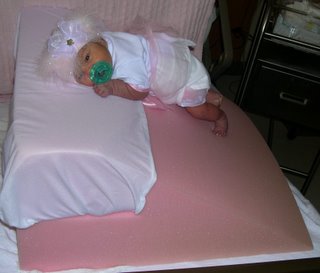She is an Occupational Therapist, specializing in infants with feeding problems. She has a great ability to establish rapport with parents, put infants at ease, and get even the most problematic babies to eat. Her ability to diagnose is nothing short of uncanny. She’s a great advocate for her patients and their families and has an absolute fan club among the pediatricians and pediatric specialists she deals with daily.
In addition to her clinical abilities, she’s also an inventor of some local reknown. With any luck, that semi-fame will spread to a national level in the not too distant future.
The invention of which I speak is an infant reflux wedge.
Your first question is, no doubt, “What the heck is an infant reflux wedge?” Allow me to explain, hopefully in brief and clear fashion.
Many adults suffer from a disorder called gastro-esophogeal reflux (GER), which those of us who are not in the medical field call “chronic heartburn”. This is a disorder in which acid from the stomach is involuntarily brought up into the esophagus and the back of the throat. We’ve all had this to some degree after a spicy Thai or Mexican meal, or a few shots of tequila. People who suffer from it chronicly know that it’s zero fun and can cause long-term damage to the upper GI. It’s now treated in adults with medications like Prilosec, Prevacid, and Nexium.
What’s less know is that infants suffer from GER as well. In fact, more infants suffer from GER than adults. GER in infants can be recognized by frequent spitting up, coughing, runny nose, sleeping problems, decreased appetite, and general irritability. Ever hear of an infant suffering from “colic”? Nine times out of ten, “colic” is really mis-diagnosed GER.
Infants with GER sleep badly, as lying horizontally causes more acid to come up into the esophagus. One of the treatments for this has been to elevate the baby on a foam rubber wedge at about 40 degrees of inclination. The baby is secured to the wedge on his/her stomach using a cloth sling.
The problem with the traditional wedge is that it’s a flat surface that pushes the baby’s shoulders back unnaturally. This can cause semi-permanent misformed postioning of the shoulders. This happened to our son – he was on the wedge for several months and now, nearly 5 years later, his shoulders are still pushed back.
My genius wife looked at our son, and looked at the wedge, and realized that there was a better way. She cut down the sides of the wedge to make a small hump in the middle. Now, when the baby is secured stomach down on the wedge, the baby’s shoulders fall forward slightly, into a much more natural position.

This sounds like a little thing, but it’s one of those things that, when viewed by pediatricians and pediatric specialists, elicits a response of, “Why didn’t I think of that?”
Robynne has partnered with a local doctor to manufacture and sell the new, improved reflux wedge to local hospitals. It’s done reasonably well with little marketing or sales support, and we’re currently talking to a few medical product distributers about including the wedge in a national catalog with a sales and marketing staff to support it.
The wedge is sold under the trademark “RES-Q Infant Wedge” and will, hopefully, be available nationally sometime in 2006. In the interim, if you have any questions about the wedge, please send me an email at phelkin@gmail.com and I’ll pass it on to Robynne.
No comments:
Post a Comment